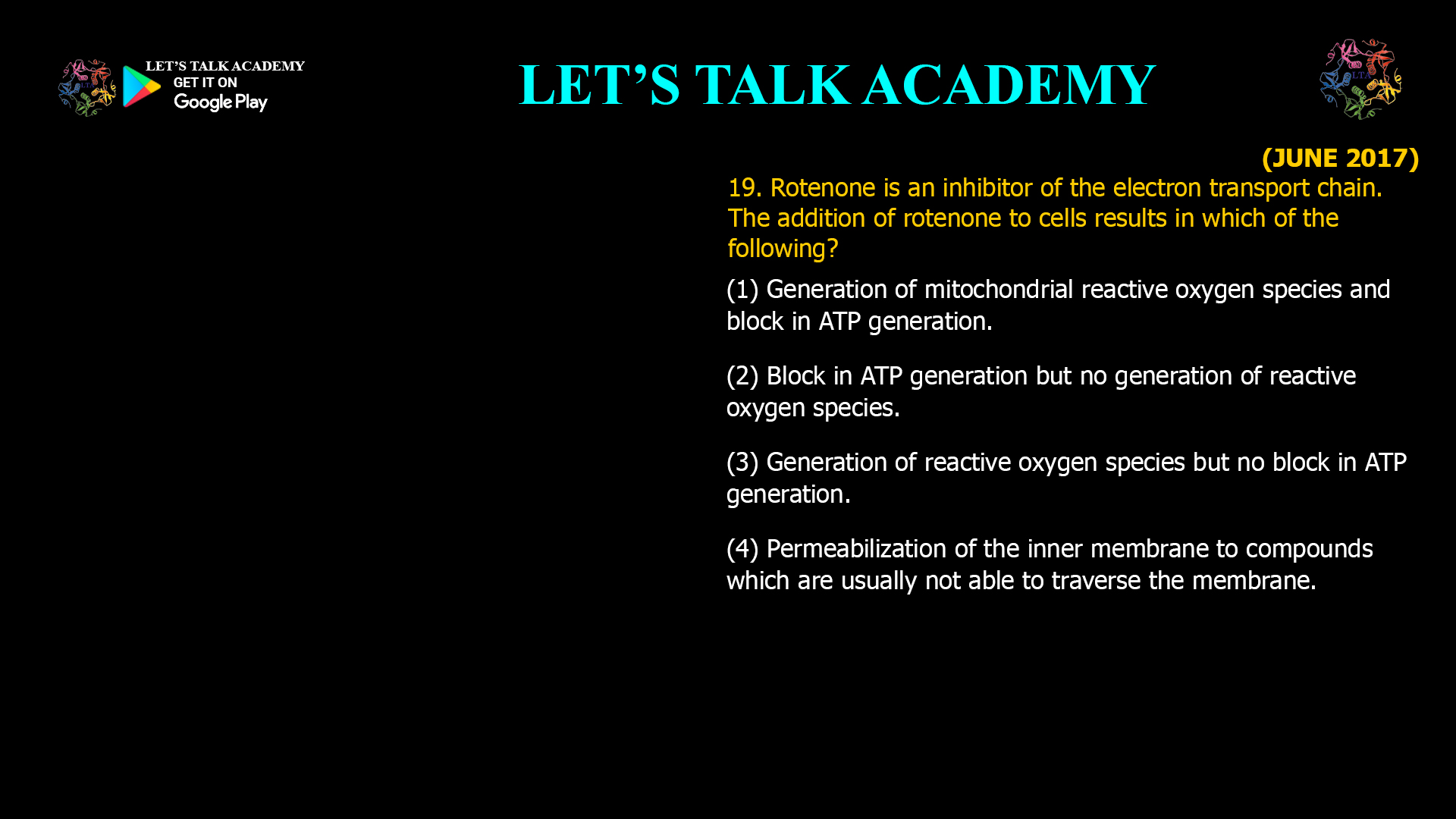19. Rotenone is an inhibitor of the electron transport chain. The addition of rotenone to cells results in which of the following?
(1) Generation of mitochondrial reactive oxygen species and block in ATP generation.
(2) Block in ATP generation but no generation of reactive oxygen species.
(3) Generation of reactive oxygen species but no block in ATP generation.
(4) Permeabilization of the inner membrane to compounds which are usually not able to traverse the membrane.
Rotenone is a well-known inhibitor of the mitochondrial electron transport chain (ETC), specifically targeting Complex I (NADH: ubiquinone oxidoreductase). Its action profoundly affects cellular energy metabolism and oxidative stress by disrupting electron flow and promoting reactive oxygen species (ROS) formation.
Mechanism of Rotenone Action
-
Rotenone binds to Complex I, blocking the transfer of electrons from the iron-sulfur centers to ubiquinone (CoQ).
-
This inhibition halts the normal electron flow through Complex I, causing a back-up of electrons within the complex.
-
As a result, oxidative phosphorylation is impaired, leading to a block in ATP generation due to disrupted proton pumping and loss of proton motive force.
Generation of Reactive Oxygen Species (ROS)
-
The electron backlog at Complex I increases the chance of electrons leaking to molecular oxygen prematurely, forming superoxide radicals and other ROS.
-
These ROS can damage mitochondrial DNA, proteins, and lipids, contributing to mitochondrial dysfunction and cell death.
-
Rotenone-induced ROS production is a significant factor in its toxicity and is used experimentally to model oxidative stress-related diseases like Parkinson’s disease.
Summary of Effects
| Effect | Explanation |
|---|---|
| Block in ATP generation | Electron transport inhibition prevents proton gradient formation and ATP synthesis. |
| Generation of mitochondrial ROS | Electron leakage from Complex I leads to ROS formation. |
Why Other Options Are Incorrect
| Option | Explanation | Correctness |
|---|---|---|
| (1) Generation of mitochondrial reactive oxygen species and block in ATP generation | Correct; rotenone causes both effects. | Correct |
| (2) Block in ATP generation but no generation of reactive oxygen species | Incorrect; ROS generation occurs. | Incorrect |
| (3) Generation of reactive oxygen species but no block in ATP generation | Incorrect; ATP generation is blocked. | Incorrect |
| (4) Permeabilization of the inner membrane to compounds | Incorrect; rotenone does not permeabilize membranes. | Incorrect |
Final Answer:
(1) Generation of mitochondrial reactive oxygen species and block in ATP generation




7 Comments
Pallavi Ghangas
September 23, 2025Generation of mitochondrial reactive oxygen species and block in ATP generation
Kirti Agarwal
September 24, 2025Opt 1
Roopal Sharma
September 25, 2025Blockage of atp generation and formation of reactive oxygen species.
Heena Mahlawat
September 25, 2025Generates ros and block atp
Manisha choudhary
September 26, 2025Rotenone complex -1 (NADH:Ubiquinone oxidoreductase ) ko block krta h
Fes s Ubiquinone ko election transfer ko block krta h
Reactive oxygen bnti h
Jo mitrochondria DNA , protein,.. ko damage kr skti h jis s cell death ho jati h
Oxydative stress hota h
Metabolic disease ho skti h
Like Parkinson
Kajal
October 4, 2025Ros generation and ATP block
Rishu
November 25, 2025Generation of mitochondrial reactive oxygen species and block in ATP generation